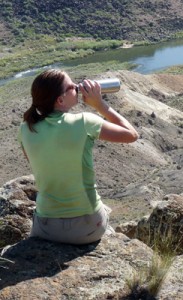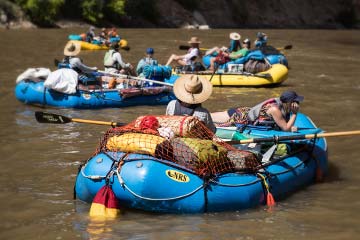
Boaters and Dehydration
 Dehydration, or excessive loss of bodily fluids, is a common problem in a number of athletic endeavors, and it’s often a problem that boaters experience. The average sedentary adult loses a bit over 2.5 quarts of water every day by:
Dehydration, or excessive loss of bodily fluids, is a common problem in a number of athletic endeavors, and it’s often a problem that boaters experience. The average sedentary adult loses a bit over 2.5 quarts of water every day by:
- Breathing. Our lungs humidify the air we inhale. When you exhale, some moisture is lost. You can see that visually on a cold day. Most of the time, we don’t see this loss and therefore underestimate its extent.
- Sweat. Dogs pant to help regulate their internal temperature. We sweat. As our temperature increases, our skin emits perspiration, which is largely water but also contains sodium, potassium and other minerals (more on these later). As the sweat evaporates, it cools the skin, and the blood right under the skin. This cooled blood circulates and lowers body temperature.
- Urine and fecal material. In addition to the waste products that need to be eliminated, some water is also lost.
Kayaking, rafting, SUP, canoeing and other watersports can be quite strenuous, resulting in greater fluid loss. The American Dietetic Association uses this scale for the progressive effects of dehydration:
| Loss of body water | Progressive effects |
|---|---|
| 0–1% | Thirst |
| 2–5% | Dry mouth, flushed skin, fatigue, headache, impaired physical performance |
| 6% | Increased body temperature, rate of breathing and pulse rate, dizziness, weakness |
A 2% loss of body weight in the form of fluid loss isn’t that much. In a 175-pound person, that’s just 56 ounces of water, less than one-half gallon (64 ounces). Yet just that much loss is already putting you into the area of fatigue and impaired performance.
How do boaters get dehydrated?
- Obviously, as we paddle and row vigorously, we breathe out more moist air and sweat more profusely. Solution: just replace those fluids.
- It can be difficult for us to drink. Our hands are full, and the demands of keeping the boat under control can make us delay replenishing our fluids. Solution: use a hydration system like the PFD Hydration Pack. A deck-mounted unit like the Camelbak Cortez Hydration Pack is a handy source for kayakers. In some cases, it may just be possible to take frequent breaks to drink up.
- It can be difficult for us to pee. If you’re boating through a built-up area where there’s no privacy, out in open water where there’s no place to stop, or in a mixed group, you may find yourself cutting back of drinking so you don’t have to pee. Solution: master the use of a pee bottle—a plastic container with a tight-fitting lid. Depending on how you’re dressed, it may not be easy for a guy, and it’s even more difficult for a gal. For you women, if you’re not familiar with a feminine urinary device (FUD) like the Whiz Freedom, you should consider giving it a try.
- In the case of boating in a mixed group, it’s best to be up front about it and just ask that heads be turned when you have to go. In a kayak out in open water, it may be necessary to have one of your boating partners steady your boat while you make things happen.
- How you dispose of the urine depends on where you’re boating. In some areas it will be okay to put it right out into the water. Elsewhere you may need to take it back to a toilet. Check for local rules and regulations.
How much liquid is enough and what kind is best?
- A good plan is to prehydrate by drinking 16-32 ounces before you get on the water. And remember, all that coffee or tea you’re drinking is a diuretic that’s causing you to lose fluids, so make sure the hydration liquids are water or fruit juices.
- While you’re on the water, try to drink 5-8 ounces every 15-20 minutes. Space consumption out since your body can only absorb so much water at one time. If you try to chug a bunch all at once, most of it will just pass through without actually hydrating you.
- After you get off the water, continue to drink fluids liberally.
- Avoid caffeinated beverages and alcohol while boating because they draw more urine out of your system. And remember, when you’re consuming them off the water, you’ll need to replace the fluid they’re causing you to lose.
- For most types of boating, just drinking water is fine for maintaining proper hydration. However, as mentioned earlier, you lose sodium and other minerals in your sweat and urine. Generally, you can replace these minerals by munching on fruit, veggies, and salty snacks like peanuts, pretzels and crackers throughout the day.
- In prolonged vigorous exercise like racing and hardcore constant paddling, especially in hot weather, you may want to add some sports drinks to your fluid intake. They contain moderate amounts of sodium and other minerals, plus some easily digestible sugar for an energy boost. It’s a good idea to pack some powdered sports drink in your emergency kit.
- Check out the handy hydration calculator in the sidebar. You plug in your weight, normal daily activity level and the intensity of the exercise or specific activity, and it gives you a recommended fluid intake per hour of exercise.
- If you want to do a little scientific experiment on your hydration level, before you go out paddling, empty your bladder and weigh yourself. While on the water drink like you normally do and record the amount of fluid you take in. When you get off the water, dry off, empty your bladder and weigh again. The difference in the two weights will be mostly water loss. And a pound of water = a pint (16 ounces).
- In Fueling the Fires Within, there’s more information on hydration and nutrition during cold-weather boating.
Boat Often, Boat Safe and Stay Hydrated!

 NRS Gift Card: Always Fits, Always Wanted
NRS Gift Card: Always Fits, Always Wanted




